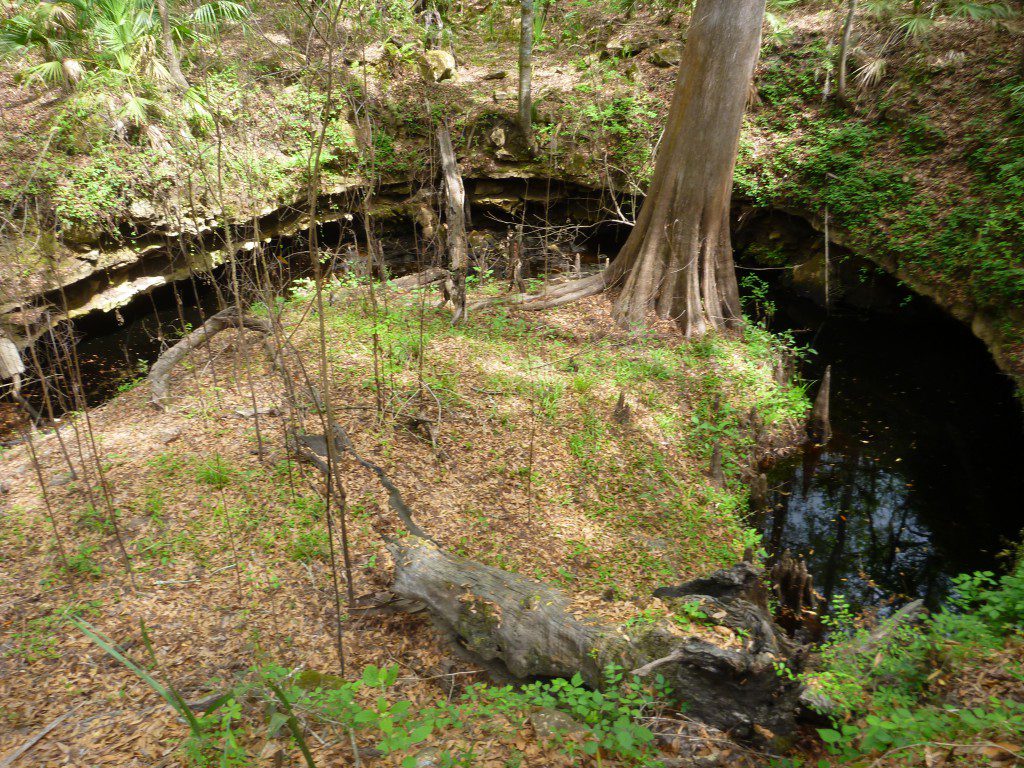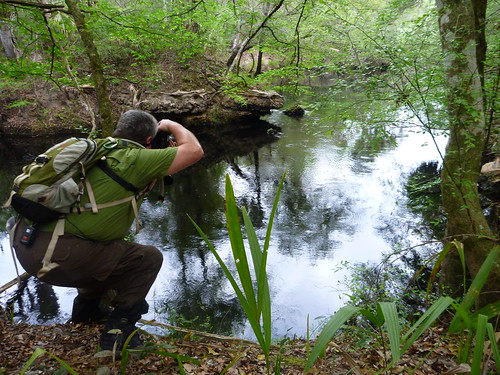We revisited the Aucilla Sinks trail in January of 2021 with state geologist Harley Means. Click to see this video to learn about geology of this marvel, how it was created, and what it can teach us about our aquifer.
Rob Diaz de Villegas WFSU-TV
Winter came and went; only it seems to not have ever really arrived. Hiking is an activity best enjoyed during the cooler months, when there are less biting insects on the trails. We shot this segment at what should have been the end of hiking season, at the end of March. What we found on the Aucilla Sinks segment of the Florida National Scenic Trail, however, were Summer temperatures, unrelenting mosquitos, and scores of white spotted ticks- the ones that carry the nasty stuff. You know what, though? We still had fun.

Pools of water and ground covered with leaves. It’s spectacular to look at, but the Aucilla Sinks are home to multitudes of insects and other critters, like pygmy rattlers.
If you wanted to explore hiking trails in the warmer months, you could very well still enjoy yourself. You just have to be prepared and know what to expect. The first thing I’ll mention- and I always mention it- is to bring water. Bring a couple of bottles. If you’re going on a long hike under a hot sun, you’re taxing your body. So drink plenty of water.
The next thing you have to worry about is mosquitos, gnats, yellow flies, and all the other fun stuff that flies and bites. Bites can be uncomfortable, and there is always the risk of catching encephalitis. I first tied to combat them with a mild, nontoxic bug spray that my wife bought for our son. It’s the kind of spray that works fine for the bugs you might encounter on a neighborhood stroll, but it was entirely ineffective against the swarms at the sinks. I had entered the day dead-set against using a spray that contained Deet, but that was all that worked that day. It lasted an hour or two before we had to reapply. It is possible to apply too much Deet, so be careful. If anyone has another solution, please share in the comments section. Covering as much of your body as possible helps, just make sure you’re using a lightweight synthetic fabric.
And lastly, some pests attack not from the sky but from the ground. I’m talking about ticks. They’re nasty, and it is no fun to pull them from your skin once they’ve latched on. Before we started our hike, Gary Hudson (who you see in the video) tucked his pants into his socks. It’s not fashionable, but it works. Kent Wimmer, our hike leader, wore gaiters, which were designed to keep snow and mud out of your boots while hiking. What Kent and Gary both did was to prevent easy access inside their clothes to the ticks. Kent took the additional precaution of sprinkling sulfur powder on his gaiters as a further deterrent. Light colored pants and shoes will let you see if there are ticks crawling on you.
These are just a few tips I gathered from our hike that day. Feel free to add your own tips in the comments section below.
Want to see more of the Florida Trail? Watch our previous segment on the Trail, where we visit the Sopchoppy River section as well as the Cathedral of Palms and Shephard Spring in the Saint Marks National Wildlife Refuge. And if that isn’t enough Refuge for you, we explore it more fully in our next EcoAdventure airing in May.
The video features music by Pitx and Bruce H. McCosar.



2 comments
[…] just recently did a video on the Trail’s Aucilla Sinks segment. Previously, Florida Trail Association’s Kent Wimmer had taken us to two very special spots […]
[…] underwater footage of Big Blue Spring. We also hiked the Florida National Scenic Trail along the Aucilla Sinks, where the Aucilla River goes intermittently underground, peeking out in “Karst […]
Comments are closed.